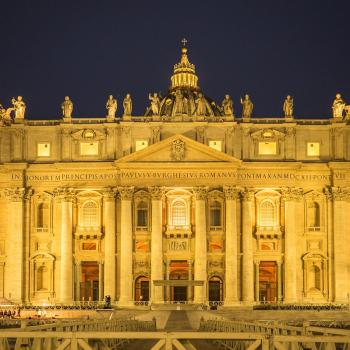Thus, Mary's sinless nature was like that of Eve's before the Fall.
Scripture scholars and theologians say Mary's role in salvation history was predicted all the way back in Genesis! You may recall after the Fall, as Adam and Eve lose their blessedness as punishment for their disobedience, a verse from Genesis 3speaks of a woman to come:
I will put enmity between you and the woman, and between your seed and her seed; he shall bruise your head, and you shall bruise his heel (Gen. 3:15).
This is what is known as the proto evangelium -- the first good news -- found and foreshadowed in the Old Testament. The future victory over the serpent (a.k.a. evil or the devil) lies in the seed of the woman . . . that seed is pre-eminently the Christ. (cf. Gal. 3:16)
Following Christ's resurrection and ascension, Paul was quick to point out this continuity to the early church.
But when the time had fully come, God sent forth his Son, born of woman . . . (Gal. 4:4).
This is why Christian references about Mary throughout history have called her the "new Eve." And why St. Jerome (4th century) remarked: "Death through Eve, life through Mary."
From among the descendants of Eve, God chose the Virgin Mary to be the mother of his Son. "Full of grace," Mary is the most excellent fruit of redemption: from the first instant of her conception, she was totally preserved from the stain of original sin and she remained pure from all personal sin throughout her life. (Catechism of the Catholic Church, 508)
Mary was the first person redeemed by Jesus by an application of the grace, from his victory over sin and death on the Cross. This requires us to think expansively -- or bigger -- beyond our own sensibilities, as it were, to consider the mysteries of God's plan for salvation.
Christian scholar Blessed Duns Scotus (d. 1308) gives a name to this: preservative redemption. Preservative redemption addresses this question of Mary's redemption taking place before her Son Jesus was even born. Mary's conception and sanctification were simultaneous.
Theologically, it is this: the unlimited God, the Creator of time, is also Lord over time. In other words, God can work outside of time. And God applies His graces throughout history (time) as He deems fit. Therefore, God, in His divine plan of salvation, willed that Mary would be saved first, in her humanity, by the application of the graces won for humanity by her Son, Jesus on the Cross.
Mary's lifetime of preparation, living with a sinless, loving heart, equipped her to make the perfect response to the Angel when he announced God's call on her life. Furthermore, Mary's Immaculate Conception provided in her body a perfectly pure temple, in a sense, for the Holy Spirit to later "overshadow."
The Son of God would take on flesh in Mary's sinless womb -- to use biblical imagery -- in a perfect tabernacle . . . the Holy of holies (Heb. 9:3) . . . the ark of the covenant (Heb. 9:4).
The splendor of an entirely unique holiness by which Mary is enriched from the first instant of her conception comes wholly from Christ: she is redeemed, in a more exalted fashion, by reason of the merits of her Son.The Father blessed Mary more than any other created person in Christ with every spiritual blessing in the heavenly places and chose her in Christ before the foundation of the world, to be holy and blameless before him in love. (Catechism of the Catholic Church, 492)
God qualified Mary for her magnificent role in salvation history by the power of his amazing grace.
So we can pray with the confidence of an Angel . . . Hail Mary, full of grace, the Lord is with thee. Blessed art thou among women . . .





